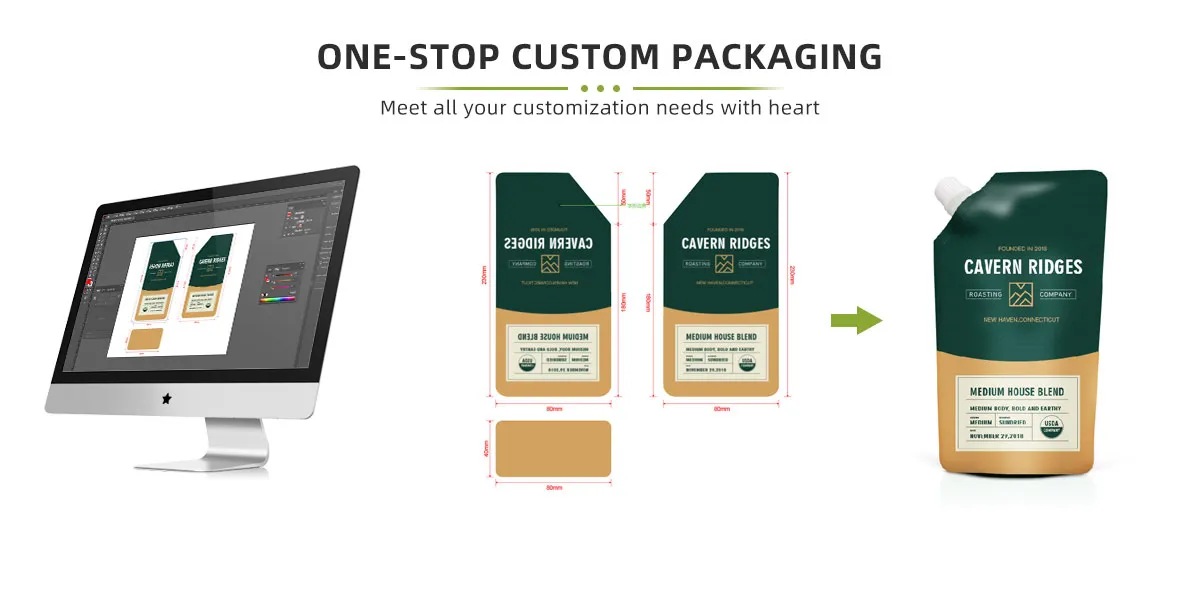Liquid pouches have become a popular packaging solution due to their convenience, durability, and eco-friendliness compared to traditional bottles and cans. They are widely used across various industries, from food and beverages to chemicals and pharmaceuticals. This guide will help you understand the basics of liquid pouches, their advantages, and applications.
The types of Liquid Pouch
Stand Up Pouch
Spout Pouch
Flat Pouches
BIB Bag In Box
The Best Material for Liquid Pouches
The choice of material for making liquid pouches is crucial to ensure product integrity, preservation, and user convenience.
When manufacturing liquid pouches, the ideal substance depends on certain criteria.
- Pouches containing beverages or foods demand materials that pose no risk to human health.
The typical material structure is PET/NY/PE. The outer PET layer provides good stiffness to show the customers’ brand on store shelves.NY layer protects the content from dropping. - Liquid pouches for holding cleaning products, lotions, shampoos, and other liquids for household or personal use, widely made from NY/PE, NY/NY/PE, and PET/NY/PE.
Nylon film with anti-drop, and the double layer of NY suitable for heavy duty. - Medical bags necessitate components known to be non-reactive and sterile.
- For transporting liquids, the choice compound should withstand vibration and impact without leakage or rupture.
NY/PE&PE is the traditional material structure for liquid bulk packaging. The outer NY layer with excellent drop resistance, and the inner individual PE layer provides secondary protection. - Industrial shipping demands construction from tough, resilient materials that can withstand rigorous handling and loading/unloading.
Depending on what is being contained, liquid pouches differ in their design
What Can be Contained in Liquid Packaging Pouch
1. Food & Beverage Products
- Water: Drinking water, flavored water, and electrolyte solutions.
- Juices & Smoothies: Fresh fruit juices, vegetable juices, and blended drinks.
- Sauces & Condiments: Ketchup, mustard, mayonnaise, barbecue sauce, and salad dressings.
- Cooking Ingredients: Oils (olive, sunflower, and coconut), syrups, and vinegars.
- Soups & Broths: Ready-to-eat soups and stock bases.
- Dairy Products: Milk, yogurt, cream, and buttermilk.
- Alcoholic Beverages: Wine, cocktails, and spirits.
- Energy Drinks & Protein Shakes: Pre-mixed fitness beverages.
2. Personal Care & Beauty Products
- Shampoos & Conditioners: Travel-sized or refillable pouches.
- Body Wash & Liquid Soaps: Ideal for single-use or refill packs.
- Lotions & Creams: Body lotions, sunscreens, and moisturizers.
- Hair Dyes: Liquid and gel-based hair coloring products.
3. Household & Cleaning Products
- Detergents & Fabric Softeners: Concentrated and diluted liquid formulations.
- Dishwashing Liquids: Handy for refill packs and compact storage.
- Cleaning Solutions: Multi-purpose cleaners, glass cleaners, and disinfectants.
4. Pharmaceutical & Healthcare Products
- Liquid Medicines: Syrups, tonics, and nutritional supplements.
- Hand Sanitizers: Alcohol-based formulations for hygiene.
- Herbal Extracts & Oils: Natural and ayurvedic products.
5. Industrial & Automotive Fluids
- Lubricants & Oils: Motor oils, grease, and industrial lubricants.
- Adhesives & Sealants: Liquid glue, epoxy, and industrial sealants.
- Paints & Coatings: Small quantities of liquid paints or varnishes.
6. Specialty & Miscellaneous Products
Chemicals: Solvents, pesticides, and fertilizers in liquid form.
Baby Products: Liquid baby food, baby formula, and cleansers.
Pet Products: Liquid pet foods, shampoos, and conditioners.
The Benefits of Liquid Pouch Packaging
Leak-Proof Design: Ensures safe transportation of liquids without spillage.
Barrier Properties: Protects contents from oxygen, moisture, and light.
Convenient Features: Spouts, caps, and resealable closures for easy use.
The Limitations of Liquid Pouch
Puncture and Tear Sensitivity:
As liquid pouches lack rigid walls, they are vulnerable to punctures, tears, or other damage that could breach the packaging integrity. Careful handling during transportation and use is essential.
Less Perceived Premium Quality:
Some consumers may still perceive pouches as less premium than rigid bottles or jars for some markets and product types.Marketing is needed to change perceptions.
Recycling availability:
While many liquid pouches are designed with environmental considerations in mind, there are still challenges related to recycling and waste management.
